How Muraudio’s new SP1 loudspeaker ($14,700 USD per pair) came to be is probably best summarized by the old adage “Necessity is the mother of invention.” The SP1 was one of the five products I wrote about last month, in “The Best of Montreal Audio Fest 2018.” However, the interesting commercial and technical stories behind it deserve more than the few words I gave it in that editorial, especially when those stories are about a brand I thought wouldn’t last more than a couple of years.
In October 2013, at the TAVES Consumer Electronics Show, held each year in Toronto, Muraudio showed a production-prototype pair of Domain Omni loudspeakers. I didn’t attend that show, but heard about the Domain Omni from audiophiles who’d seen it there and suggested I check out this fully active speaker claimed to radiate sound omnidirectionally from three electrostatic panels. I’m a big fan of omnidirectional speakers -- I love the spacious sound they can provide -- and I live in Ottawa, where Muraudio is headquartered. I made an appointment to visit them.
When I visited the following December, the Domain Omni was still a production prototype but was very close to completion and release, and I got a good taste of what the final product would look and sound like. It combined its three proprietary electrostatic panels, each curved horizontally and vertically, with three 9” cone woofers to handle all frequencies below about 450Hz. The panels and woofers were so positioned as to horizontally radiate sound through a full 360°.
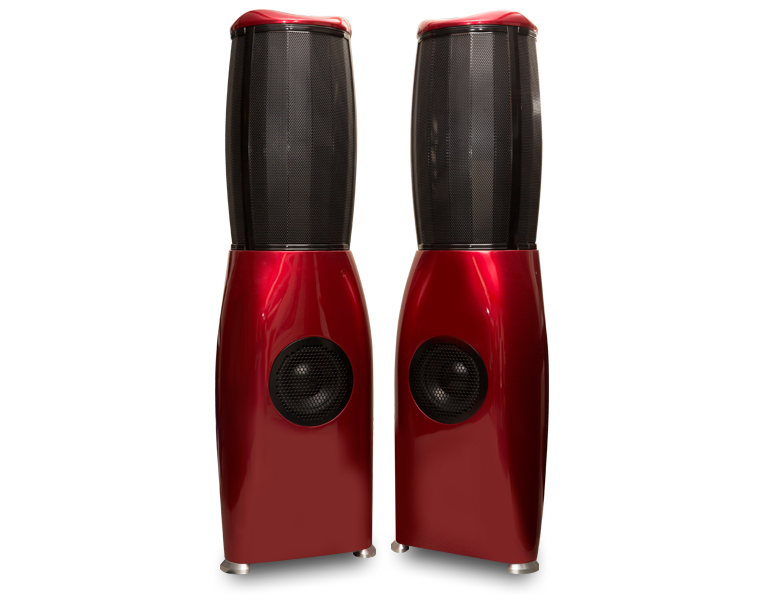
Muraudio’s eschewing of the rectangular-box look of most loudspeakers could be considered out of the box, literally and conceptually. It was far and away different from the usual rectilinear cabinet of most of today’s loudspeakers, and designer Murray Harman didn’t follow any design rules set by others -- working from scratch, he simply created the best loudspeaker he knew how. The result was a real engineering achievement, particularly in the way their electrostatic panels were curved in two directions, and in how he was able to arrange them to radiate sound through 360 degrees -- things I’d never seen done before.
In the short demo Muraudio gave me I heard powerful bass, combined with the midrange and high-frequency clarity electrostatic designs are known for. The sound filled the room, and the listening sweet spot was far wider than the usual right-in-the-center position.
That the demo was short was my choice. After I’d heard enough to know that the Domain Omni had promise, I turned to Murray Harman and his business partner, Rob Runolfson, who looks after Muraudio’s business side, and asked, “How much will the finished speaker cost?” When they looked somewhat taken aback, I explained that while the Domain Omni seemed to have the potential of being a noteworthy product, I’d seen many companies go down this road before -- not necessarily with a 360° electrostatic hybrid speaker, but with any product, speaker or electronics, designed as an assault on the state of the art -- and that few of them were still with us.
They told me that they hoped the Domain Omni would come to market for under $50,000/pair. When the final version went into production -- renamed the Domain Omni DA1, and pretty much identical to what I’d seen and heard that December -- it was priced at $69,500/pair. In March 2014, Muraudio released a passive version, the Domain Omni PX1 ($63,000/pair), followed by another passive version in 2016, the PX2, with fancier cosmetics and an improved crossover ($79,500/pair). These were hardly the most expensive speaker models you could find, even then, but they were still expensive.
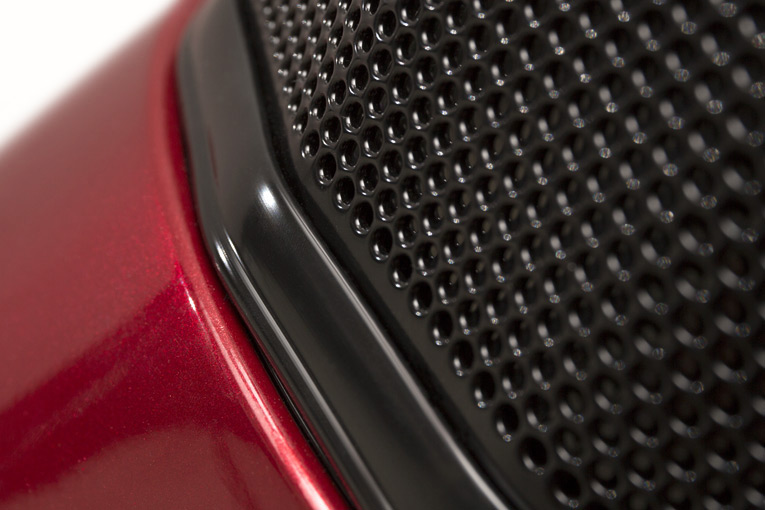
Although I favorably reviewed the Domain Omni PX1s in September 2015, I knew that, as good as they sounded in my room -- and they sounded very good -- few people buy speakers that cost $63,000/pair. Nor would it have mattered if any or all of the three models had come in for under $50,000/pair -- there just aren’t that many people able or willing to spend more than the price of an average car on a pair of speakers. Add to that the challenges of being a new, unknown brand, and you have the perfect plan for going out of business fast. But Runolfson and Harman were already thinking ahead.
In December 2017, I met again with Muraudio. This time I spoke only with Runolfson, who assured me that, since the launches of their original speakers, he and Harman had been hard at work on the business and design sides, and were going forward with the next steps in their business plan, formulated back in 2011. Later, in an e-mail, he said this:
From the beginning, we made a key business decision to develop the flagship product first. Why? Because in a market overloaded with so many products, it was critical that we first gain traction in brand awareness, market recognition, and give people the chance to see that our technology was not only unique, but sounded unlike anything done before. We did not feel we would have as much success going at it from the entry-level product first. It’s also a typical business model where early-stage products and technology are only available at a high price to the early adopters. We didn’t see this as any different.
The Domain Omni models were still in production, but Runolfson and Harman realized that now they needed to go downmarket to attract more customers while keeping their focus on technology and quality. Runolfson told me that they’d completely changed their dealer-and-distribution strategy, to provide higher value. Consumers can now buy pairs of Muraudio speakers direct from the factory, or from a dealer, at far lower prices than before: $36,900 for the DA1, $46,700 for the PX2, and $32,800 for the PX1. The build and sound qualities of all models remain unchanged.
“Now we’re talking!” I told him.
He had more big news: Murray Harman had designed a new electrostatic-based speaker Muraudio thought it could sell for less than $15,000/pair, though it was then only a rough prototype, still too early in its development to show me. There are many more people who can spend 15 grand on speakers than who can spend 30, 50, or 80 grand. I told Runolfson that I thought they stood a much better chance of success with the new model, especially as they now had a more established name and a track record.
Three months later, at the 2018 Montreal Audio Fest, I saw the finished version, now dubbed the SP1. I was a little puzzled by its driver configuration. I think many others will be confused at first, too, and that could turn some away -- though it shouldn’t if their concern is good sound.
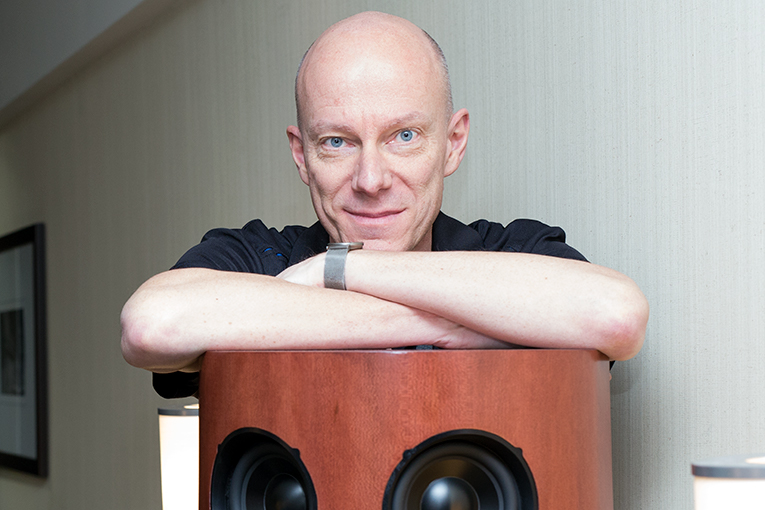 Murray Harman and a wood-finished SP1
Murray Harman and a wood-finished SP1
The SP1 has one of Muraudio’s proprietary electrostatic panels -- SP stands for single panel. It reproduces audio frequencies from 750Hz up, and is mounted in a thick, very curved, mostly open-backed cabinet of birch plywood. Because the area behind the panel is open, the panel operates as a dipole, radiating as much energy rearward as forward, its rear-firing output out of phase with its forward-firing output. To reproduce frequencies below 750Hz the SP1 has four 6.5” dynamic drivers (that’s the driver’s frame size; the cone is about 5” across). These drivers are arrayed in pairs above and below the electrostatic panel, sunk about 2” into the enclosure -- which, per Harman, improves their phase alignment of their output with the panel’s output. The cones also point slightly to the side, not straight ahead, to improve dispersion over an arc of about 120°, and to ideally match the panel’s dispersion characteristics. Unlike the panel, however, each of these drivers is in its own sealed enclosure -- its cone directs soundwaves only forward, into the room, while its rear-directed energy is absorbed by the enclosure. Muraudio specifies for the SP1 a frequency response of 45Hz-22kHz, ±3dB, and a maximum output of 103dB measured at 2m.
The SP1 demonstrates that, when he designed it, Murray Harman was again thinking way outside the traditional loudspeaker box -- definitely a good thing when the focus is strictly on sound quality. But that has some side effects . . .

Two things about the SP1’s driver configuration bugged me. One is the overall appearance: four dynamic drivers and an electrostatic panel, no matter how you arrange them or how nicely you finish the cabinet, look a little weird. I can only say that, much like the Muraudio speakers that came before it, in the SP1 form follows function. The other thing has to do with the drivers’ sizes and the frequencies they reproduce. Typically, the bigger the driver, the lower the frequencies it reproduces -- for example, big woofers make bass, tiny tweeters make highs, midsize drivers make the midrange. In this case, the biggest driver -- the electrostatic panel -- handles the higher frequencies, while the smaller drivers handle everything lower. That seems counterintuitive. Granted, the supplied grille covers it all up, but since what we hear can be greatly affected by what we see, it was disconcerting for me at first to listen to such an odd driver arrangement. As a result, I left Montreal once again thinking that while Muraudio’s new speaker showed real promise, I wasn’t completely sold -- I knew I needed to get a pair into my listening room, where I could hear them under known conditions to better understand what they could and couldn’t do.
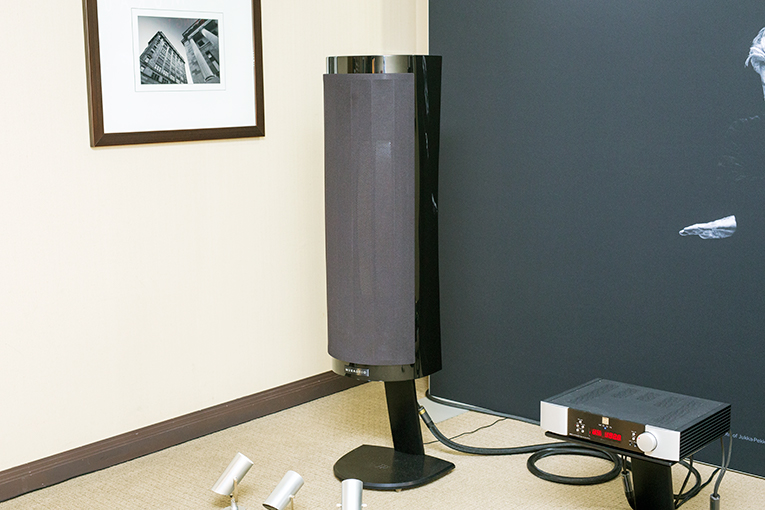 Montreal Audio Fest 2018
Montreal Audio Fest 2018
A week and a half later, Harman and Runolfson delivered the same shiny-black pair of SP1s they’d demonstrated at the Montreal Audio Fest, and set them up with their grilles on -- Harman told me that the grilles are acoustically transparent. The moment they left, I pulled the grilles off, cued up a track, and immediately had the same feeling I’d had in Montreal -- it was just so weird to see drivers arranged that way, and weirder still to have the smaller drivers make the lows and the bigger one the highs.
But the more I listened, the more my ears overruled what my eyes were seeing. I began realizing that the SP1s were doing some things better than almost any other speaker I’ve had in my room -- imaging like gangbusters, rendering depth like there’s no tomorrow, and “disappearing” so completely into the soundstage that they seemed not to be there at all. Is Murray Harman on to something with the SP1’s seemingly oddball driver placements? I also found that, despite the differences in driver types, dynamic and electrostatic, and their strange positioning on the enclosure, I could hear no trace of where the cones handed off to the panel. The sound was utterly seamless. None of this was what I’d expected to hear when I first saw the SP1 in Montreal.
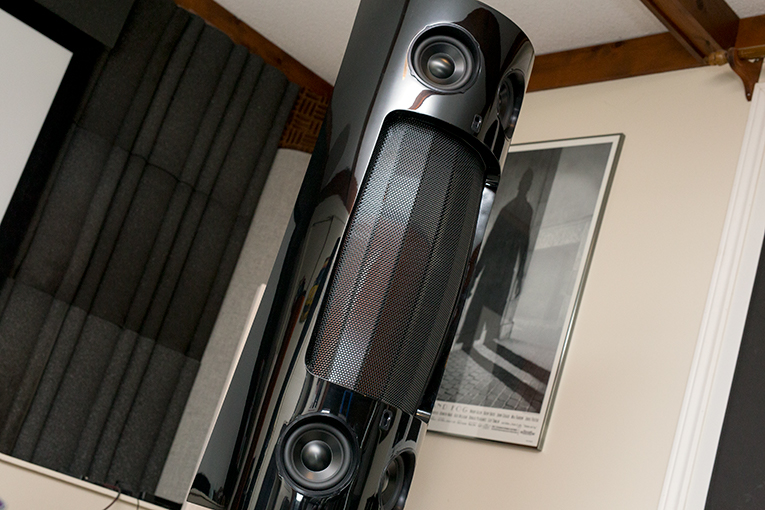 In Doug Schneider’s room
In Doug Schneider’s room
I still have more listening to do, and I haven’t yet begun writing my review of the SP1 -- I know I’ll have a lot more to say about it. Also, my full review, when published, will include measurements of the SP1 taken in the anechoic chamber of Canada’s National Research Council. But I felt it prudent to shed some more light on this unique new loudspeaker now, beyond the insights I shared from Montreal Audio Fest 2018. Another old adage applies to the SP1: “Looks can be deceiving.” Right now, the SP1 is on track for being one of the most important speakers I’ve reviewed in a while. My full review will be on this site in June.
. . . Doug Schneider
das@soundstagenetwork.com






















